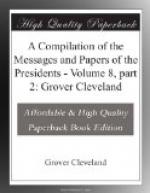Upon the declaration of war against Mexico by Congress the United States were entitled to all the rights which any other nation at war would have possessed. These rights could only be demanded and enforced by the President, whose duty it was, as “Commander in Chief of the Army and Navy of the United States,” to execute the law of Congress which declared the war. In the act declaring war Congress provided for raising men and money to enable the President “to prosecute it to a speedy and successful termination.” Congress prescribed no mode of conducting it, but left the President to prosecute it according to the laws of nations as his guide. Indeed, it would have been impracticable for Congress to have provided for all the details of a campaign.
The mode of levying contributions must necessarily be left to the discretion of the conqueror, subject to be exercised, however, in conformity with the laws of nations. It may be exercised by requiring a given sum or a given amount of provisions to be furnished by the authorities of a captured city or province; it may be exercised by imposing an internal tax or a tax on the enemy’s commerce, whereby he may be deprived of his revenues, and these may be appropriated to the use of the conqueror. The latter mode was adopted by the collection of duties in the ports of Mexico in our military occupation during the late war with that Republic.
So well established is the military right to do this under the laws of nations that our military and naval officers commanding our forces on the theater of war adopted the same mode of levying contributions from the enemy before the order of the President of the 31st of March, 1847, was issued. The general in command of the Army at Vera Cruz, upon his own view of his powers and duties, and without specific instructions to that effect, immediately after the capture of that city adopted this mode. By his order of the 28th of March, 1847, heretofore communicated to the House of Representatives, he directed a “temporary and moderate tariff of duties to be established.” Such a tariff was established, and contributions were collected under it and applied to the uses of our Army. At a still earlier period the same power was exercised by the naval officers in command of our squadron on the Pacific coast. ... Not doubting the authority to resort to this mode, the order of the 31st of March, 1847, was issued, and was in effect but a modification of the previous orders of these officers, by making the rates of contribution uniform and directing their collection in all the ports of the enemy in our military occupation and under our temporary military government.




